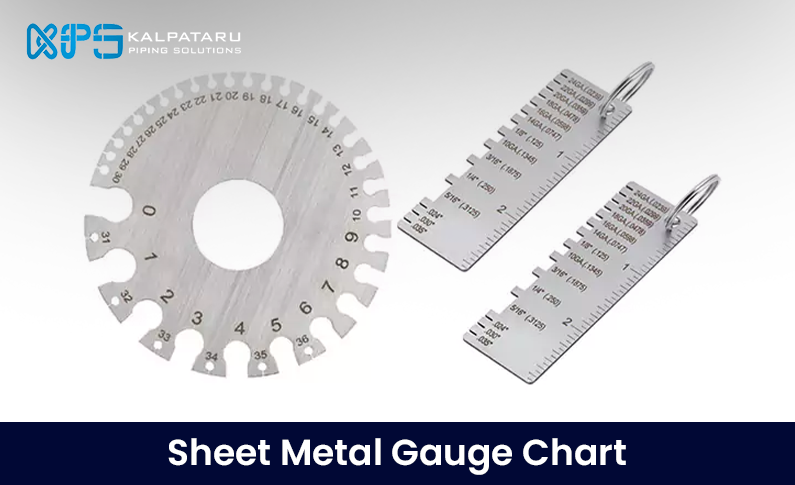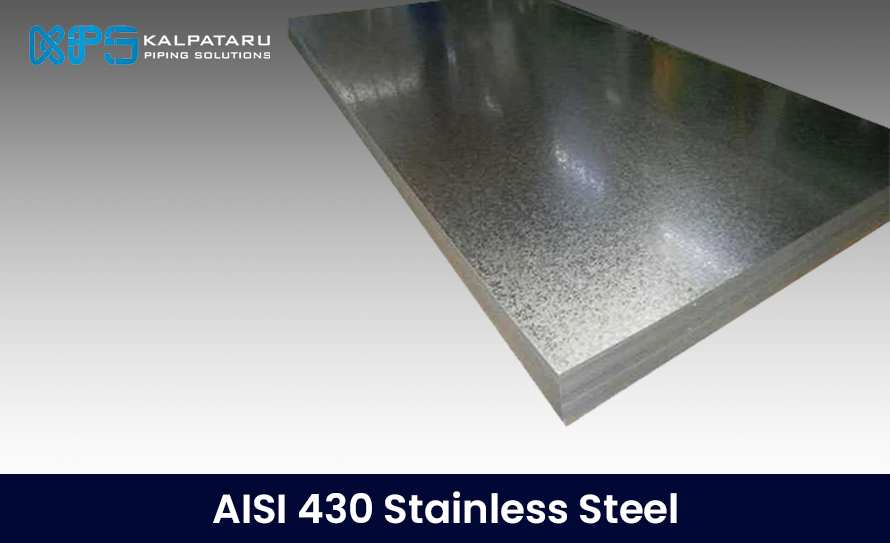Gauge sizes show the thickness of sheet metal, where a higher gauge number means a thinner sheet. Gauges are represented by numbers, and tables provide decimal equivalents for each gauge. When ordering sheet metal, it’s generally recommended to specify both the gauge number and the precise decimal thickness. While gauges should align with standard sizes for each material, discrepancies may occur if rounded or approximate values are used. Providing exact measurements in decimal form, alongside the gauge, helps avoid errors and ensures accurate communication with the manufacturer when placing orders.
What is Sheet Metal Gauge? – Metal Gauge Thickness
Sheet metal gauge refers to the thickness of the metal, with lower gauge numbers indicating thicker sheets (except for zinc). In general, larger gauge numbers mean thinner sheets. Sheet metal thickness is often measured in thousandths of an inch (mils) or millimeters, depending on the standard used.
Common sheet metal gauges range from 30 to 14. In American scrap yards, it’s typical to use thousandths of an inch for measurement. There are also special gauge numbers like 000000 and 0, used for materials such as aluminum and stainless steel. In this system, a gauge of 000000 is thicker than a 0 gauge. The largest gauge, 0000000, corresponds to 0.5 inches, while the smallest gauge, 0, equals 0.1875 inches.
How are Sheet Metal Gauges Used?
Sheet metal gauges are used to indicate the thickness of metal sheets. Unlike standard or metric measurements, gauge values are independent of those systems. To find the genuine thickness of sheet metal, you can refer to a gauge conversion chart. For example, 18 gauge steel measures 0.0478 inches (or 1.214 millimeters), but the gauge number “18” itself doesn’t directly relate to these measurements.
Different materials have their own gauge systems. For instance, while 18 gauge steel is 0.0478 inches thickness, 18 gauge aluminum measures only 0.0403 inches thickness. Because of these differences in thickness based on material type, using a gauge chart is essential to ensure the metal you need meets the correct specifications.
History of the Gauge System
The gauge system has a rich history in metal fabrication, originating from the British wire industry before standard and metric measurements became common. Initially, gauges were used to measure the diameter of drawn metal wire. Over time, this system evolved and became a popular way to specify the thickness of both wire and sheet metal. Today, the gauge system continues to be an essential tool in the industry for determining material thickness.
Sheet Metal Gauge Size Table Chart
Use these sheet metal gauge charts to easily identify the right metal thickness for your project.
Sheet Metal Gauge Chart
| Gauge # | Brass & Aluminum Sheets (Inches) | Brass & Aluminum Sheets (MM) | Cold & Hot Rolled Steel Sheets (Inches) | Cold & Hot Rolled Steel Sheets (MM) | Alu., Copper, Brass & Steel Tubes, Copper Sheets, Hoop Steel (Inches) | Alu., Copper, Brass & Steel Tubes, Copper Sheets, Hoop Steel (MM) | Stainless Steel Sheets (Inches) | Stainless Steel Sheets (MM) | Galvanized Steel Sheets (Inches) | Galvanized Steel Sheets (MM) |
| 7 | 0.1443 | 3.665 | 0.1793 | 4.554 | 0.18 | 4.572 | 0.187 | 4.765 | 0.1681 | 4.269 |
| 8 | 0.1285 | 3.264 | 0.1644 | 4.175 | 0.165 | 4.191 | 0.17187 | 4.365 | 0.1516 | 3.849 |
| 9 | 0.1144 | 2.906 | 0.1495 | 3.797 | 0.148 | 3.759 | 0.15625 | 3.968 | 0.1382 | 3.51 |
| 10 | 0.1019 | 2.588 | 0.1345 | 3.417 | 0.134 | 3.403 | 0.14062 | 3.571 | 0.1233 | 3.132 |
| 11 | 0.09074 | 2.305 | 0.1196 | 3.038 | 0.12 | 3.048 | 0.125 | 3.175 | 0.1116 | 2.835 |
| 12 | 0.08081 | 2.052 | 0.1046 | 2.657 | 0.105 | 2.667 | 0.10937 | 2.778 | 0.0994 | 2.524 |
| 14 | 0.06408 | 1.628 | 0.0747 | 1.897 | 0.074 | 1.879 | 0.07812 | 1.984 | 0.0785 | 1.993 |
| 16 | 0.05082 | 1.291 | 0.0598 | 1.518 | 0.06 | 1.524 | 0.0625 | 1.587 | 0.0635 | 1.612 |
| 18 | 0.0403 | 1.024 | 0.0478 | 1.214 | 0.048 | 1.219 | 0.05 | 1.27 | 0.0516 | 1.31 |
| 20 | 0.03204 | 0.814 | 0.0359 | 0.912 | 0.036 | 0.914 | 0.0375 | 0.952 | 0.0396 | 1.005 |
| 22 | 0.02535 | 0.644 | 0.0299 | 0.759 | 0.03 | 0.762 | 0.03125 | 0.793 | 0.0316 | 0.802 |
| 24 | 0.0201 | 0.511 | 0.0239 | 0.607 | 0.024 | 0.609 | 0.025 | 0.635 | 0.0256 | 0.651 |
| 26 | 0.01594 | 0.405 | 0.0179 | 0.454 | 0.018 | 0.457 | 0.01875 | 0.476 | 0.0187 | 0.475 |
| 28 | 0.01264 | 0.321 | 0.0149 | 0.378 | 0.015 | 0.381 | 0.01562 | 0.397 | 0.0156 | 0.396 |
| 30 | 0.01003 | 0.255 | 0.012 | 0.305 | 0.012 | 0.305 | 0.0125 | 0.317 | 0.0118 | 0.398 |
Mild Steel Gauge Chart
| Mild Steel Gauge Chart | ||
| Gauge Number |
Inches | MM |
| 7 | .1793 | 4.554 |
| 8 | .1644 | 4.175 |
| 9 | .1495 | 3.797 |
| 10 | .1345 | 3.416 |
| 11 | .1196 | 3.038 |
| 12 | .1046 | 2.656 |
| 14 | .0747 | 1.897 |
| 16 | .0598 | 1.518 |
| 18 | .0478 | 1.214 |
| 20 | .0359 | .911 |
| 22 | .0299 | .759 |
| 24 | .0239 | .607 |
| 26 | .0179 | .454 |
| 28 | .0149 | .378 |
Aluminum Gauge Chart
| Aluminum Gauge Chart* | ||
| Gauge Number | Inches | MM |
| 7 | .1443 | 3.665 |
| 8 | .1285 | 3.264 |
| 9 | .1144 | 2.906 |
| 10 | .1019 | 2.588 |
| 11 | .09074 | 2.305 |
| 12 | .08081 | 2.053 |
| 14 | .06408 | 1.628 |
| 16 | .05082 | 1.291 |
| 18 | .04030 | 1.024 |
| 20 | .03196 | .812 |
| 22 | .02535 | .644 |
| 24 | .02010 | .511 |
| 26 | .01594 | .405 |
| 28 | .01264 | .321 |
| 30 | .01003 | .255 |
Stainless Steel Gauge Chart
| Stainless Steel Gauge Chart | ||
| Gauge Number |
Inches | MM |
| 8 | .17187 | 4.365 |
| 9 | .15625 | 3.968 |
| 10 | .14062 | 3.571 |
| 11 | .125 | 3.175 |
| 12 | .10937 | 2.778 |
| 14 | .07812 | 1.984 |
| 16 | .0625 | 1.587 |
| 18 | .050 | 1.270 |
| 20 | .0375 | .9525 |
| 22 | .03125 | .7937 |
| 24 | .025 | .635 |
| 26 | .01875 | .476 |
| 28 | .01562 | .396 |
| 30 | .0125 | .3175 |
Galvanized Steel Gauge Chart
| Galvanized Steel Gauge Chart* | ||
| Gauge Number | Inches | MM |
| 8 | .1681 | 4.269 |
| 9 | .1532 | 3.891 |
| 10 | .1382 | 3.510 |
| 11 | .1233 | 3.1318 |
| 12 | .1084 | 2.753 |
| 14 | .0785 | 1.9939 |
| 16 | .0635 | 1.6129 |
| 18 | .0516 | 1.310 |
| 20 | .0396 | 1.005 |
| 22 | .0336 | .853 |
| 24 | .0276 | .701 |
| 26 | .0217 | .551 |
| 28 | .0187 | .474 |
| 30 | .0157 | .398 |
Brass Gauge Chart
| Brass Gauge Chart | ||
| Gauge Number |
Inches | MM |
| 7 | .1443 | 3.665 |
| 8 | .1285 | 3.264 |
| 9 | .1144 | 2.906 |
| 10 | .1019 | 2.588 |
| 11 | .09074 | 2.305 |
| 12 | .08081 | 2.053 |
| 14 | .06408 | 1.628 |
| 16 | .05082 | 1.291 |
| 18 | .04030 | 1.024 |
| 20 | .03196 | .812 |
| 22 | .02535 | .644 |
| 24 | .02010 | .511 |
| 26 | .01594 | .405 |
| 28 | .01264 | .321 |
| 30 | .01003 | .255 |
Copper Gauge Chart
| Copper Gauge Chart | ||
| Gauge Number |
Inches | MM |
| 7 | .180 | 4.572 |
| 8 | .165 | 4.191 |
| 9 | .148 | 3.759 |
| 10 | .134 | 3.404 |
| 11 | .120 | 3.048 |
| 12 | .109 | 2.769 |
| 14 | .083 | 2.108 |
| 16 | .065 | 1.651 |
| 18 | .049 | 1.245 |
| 20 | .035 | .889 |
| 22 | .028 | .711 |
| 24 | .022 | .559 |
| 26 | .018 | .457 |
| 28 | .014 | .356 |
| 30 | .012 | .305 |
Summary
The gauge system has a long history in metal fabrication, starting in the British wire industry as a way to measure wire diameters. It has since expanded to include sheet metal thicknesses.
Even with the rise of standard and metric measurements, the gauge system is still commonly used because it provides a straightforward way to specify metal thickness, which aids clear communication in the industry. Although gauge numbers do not directly match inches or millimeters, conversion charts help professionals achieve accurate measurements across different gauge sizes.
The gauge system remains relevant in metal fabrication due to its historical significance, widespread acceptance, and practical use. It is an essential tool for those in manufacturing, construction, and related fields, ensuring precise measurements and effective communication for successful projects.
FAQs
What is 18 gauge thickness?
18 gauge steel has a thickness of 0.0478 inches, whereas 18 gauge aluminum measures 0.0403 inches in thickness.
What is the standard gauge for sheet metal?
The standard sheet metal gauge ranges from 30 (thin) to 7 (thick), with actual thickness varying by metal type. Some metals can be produced in gauges up to 36 or down to 3.
Which is thicker, 18 or 20 gauge sheet metal?
18 gauge sheet metal is thicker than 20 gauge. The gauge number corresponds to the number of reductions in wire size, making 18 gauge larger than 20 gauge.




